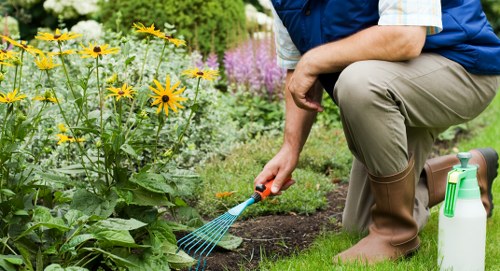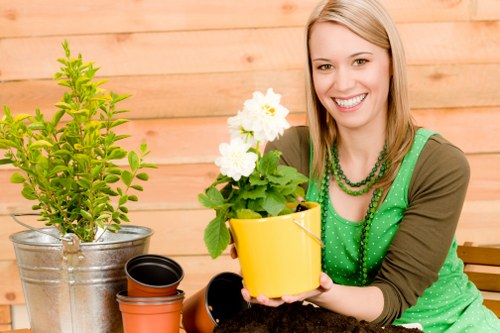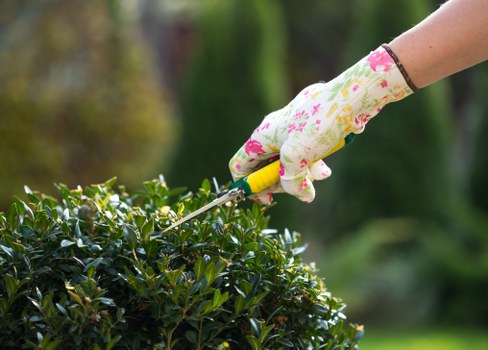Garden Maintenance in Belmont: Transforming Your Outdoor Space
Introduction to Garden Maintenance

Maintaining a beautiful garden in Belmont requires dedication, knowledge, and the right strategies. Whether you are a seasoned gardener or a novice, understanding the essentials of garden upkeep can significantly enhance the appeal and functionality of your outdoor space.
Gardening not only adds aesthetic value to your home but also provides a peaceful retreat where you can relax and connect with nature. Proper garden maintenance ensures that your plants thrive, pests are kept at bay, and your landscape remains vibrant throughout the year.
In this article, we will explore the comprehensive aspects of garden maintenance in Belmont, offering tips and insights to help you achieve a lush and healthy garden.
Understanding Belmont’s Climate and Its Impact on Gardening

Belmont enjoys a temperate climate, which plays a crucial role in determining the types of plants that can thrive in the area. Understanding the local weather patterns, soil types, and seasonal changes is essential for effective garden maintenance.
Climate Considerations:
- Temperature: Belmont experiences mild winters and warm summers, allowing for a diverse range of plants.
- Rainfall: Adequate rainfall supports plant growth, but it’s important to manage water effectively to prevent issues like root rot.
- Humidity: The region’s humidity levels can affect plant health, making it essential to choose moisture-tolerant species.
By tailoring your gardening practices to Belmont’s climate, you can ensure that your garden remains resilient and flourishing year-round.
Essential Garden Maintenance Tasks

1. Regular Weeding
Weeding is a fundamental aspect of garden maintenance. Removing unwanted plants prevents competition for nutrients and water, ensuring that your desired plants receive adequate resources.
Tips for Effective Weeding:
- Weed after rainfall when the soil is moist for easier removal.
- Use appropriate tools to avoid disturbing plant roots.
- Consider mulching to reduce weed growth.
2. Pruning and Trimming
Pruning helps maintain the shape and health of your plants. It encourages new growth, removes dead or diseased branches, and improves air circulation.
Best Practices:
- Prune in the early morning to reduce stress on plants.
- Use sharp, clean tools to make precise cuts.
- Understand the specific pruning needs of each plant species.
3. Soil Health Management
Healthy soil is the foundation of a thriving garden. Regularly testing and amending your soil ensures that it remains fertile and well-draining.
Seasonal Care for Your Garden

Different seasons require tailored maintenance strategies to keep your garden in optimal condition. Here's how to adapt your care routine throughout the year:
Spring Maintenance
- Prepare beds by removing debris and adding compost.
- Plant new flowers and vegetables.
- Start regular watering schedules as temperatures rise.
Summer Care
During the hot months, focus on irrigation, pest control, and maintaining plant health to withstand the heat.
Summer Tips:
- Water early in the morning to minimize evaporation.
- Shade sensitive plants during peak sunlight.
- Monitor for pests and diseases regularly.
Autumn Preparation
As the weather cools, prepare your garden for the winter by cleaning up fallen leaves and protecting sensitive plants.
Choosing the Right Plants for Belmont Gardens

Selecting plants that are well-suited to Belmont’s climate and soil conditions is crucial for a successful garden. Consider native species and those that require similar care and maintenance.
Popular Plant Varieties:
- Hydrangeas: Thrive in Belmont’s climate and add vibrant color.
- Lavender: Known for its fragrance and drought resistance.
- Hostas: Perfect for shaded areas and easy to maintain.
- Roses: A classic choice that brings elegance to any garden.
- Vegetable Varieties: Tomatoes, peppers, and herbs are excellent choices for home gardens.
Incorporating Evergreen Plants
Evergreen plants provide year-round structure and greenery, enhancing the visual appeal of your garden even in the colder months.
Integrated Pest Management (IPM) in Belmont
Effective pest control is vital for maintaining plant health without relying heavily on chemicals. Integrated Pest Management (IPM) combines biological, cultural, and chemical methods to manage pests sustainably.
Key Components of IPM:
- Monitoring: Regularly inspect plants for signs of pests and diseases.
- Biological Control: Introduce natural predators like ladybugs and parasitic wasps.
- Cultural Practices: Rotate crops and maintain plant diversity to reduce pest habitats.
- Chemical Control: Use pesticides as a last resort, opting for environmentally friendly options.
Implementing IPM strategies ensures a balanced ecosystem in your garden, promoting healthy plant growth and minimizing pest-related issues.
Water Management for a Thriving Garden
Proper irrigation is essential for maintaining plant health, especially during dry spells. Efficient water management practices conserve resources and promote sustainable gardening.
Effective Irrigation Techniques:
Drip Irrigation
Drip irrigation delivers water directly to the plant roots, reducing evaporation and ensuring efficient water use.
Rainwater Harvesting
Collecting rainwater is an eco-friendly way to supply your garden with necessary moisture while reducing dependency on municipal water sources.
Mulching
Applying mulch helps retain soil moisture, regulate temperature, and suppress weed growth.
Water Conservation Tips:
- Water plants during the early morning or late evening to minimize evaporation.
- Use water-efficient irrigation systems.
- Group plants with similar water needs together.
Soil Fertilization and Composting
Feeding your plants with the right nutrients is crucial for their growth and productivity. Soil fertilization and composting are effective ways to enrich your garden’s soil.
Benefits of Composting:
- Improves soil structure and fertility.
- Enhances water retention and drainage.
- Reduces the need for chemical fertilizers.
Fertilization Best Practices:
Organic Fertilizers
Organic options like bone meal, blood meal, and fish emulsion provide a natural nutrient boost without harming the environment.
Chemical Fertilizers
If opting for chemical fertilizers, choose slow-release formulas to prevent over-fertilization and reduce runoff.
Soil Testing
Regular soil testing helps determine nutrient deficiencies and guides appropriate fertilization strategies.
Maintaining Garden Tools and Equipment
Well-maintained tools and equipment are essential for efficient garden maintenance. Proper care extends their lifespan and ensures they perform optimally.
Essential Garden Tools:
- Pruners and shears for trimming plants.
- Shovels and spades for digging and planting.
- Rakes and hoes for soil preparation and weed control.
- Lawn mowers and trimmers for maintaining grassy areas.
Tool Maintenance Tips:
Cleaning:
Regularly clean your tools to remove dirt, sap, and debris that can cause rust and deterioration.
Sharpening:
Keep blades sharp for efficient cutting and to prevent damaging plants.
Storage:
Store tools in a dry, sheltered area to protect them from the elements and extend their lifespan.
Lawn Care and Maintenance
A well-maintained lawn enhances the overall appearance of your garden. Proper lawn care involves mowing, fertilizing, aerating, and pest control.
Key Lawn Care Practices:
- Mowing: Regular mowing at the appropriate height promotes healthy grass growth.
- Fertilizing: Apply fertilizers to provide essential nutrients for a lush lawn.
- Aerating: Aerate the soil to improve airflow and water penetration.
- Pest Control: Monitor for lawn pests and address issues promptly.
Choosing the Right Grass Type:
Selecting a grass variety suited to Belmont’s climate ensures a resilient and attractive lawn. Common choices include Kentucky bluegrass, fescue, and Bermuda grass.
Enhancing Your Garden with Hardscaping
Hardscaping elements like pathways, patios, and retaining walls add structure and functionality to your garden. These features complement the natural beauty of your plants and provide areas for relaxation and entertainment.
Popular Hardscaping Features:
- Patios: Create outdoor living spaces for dining and gatherings.
- Pathways: Guide visitors through your garden and connect different areas.
- Retaining Walls: Manage soil erosion and add visual interest.
- Decks: Provide elevated platforms for additional seating and enjoyment.
Maintaining Hardscaping Elements:
Regular cleaning and inspections help preserve hardscaping features. Address any cracks or damage promptly to maintain safety and aesthetics.
Incorporating Sustainable Practices
Adopting sustainable gardening practices contributes to environmental conservation and creates a healthier garden ecosystem.
Sustainable Gardening Tips:
- Use Native Plants: Native species are well-adapted to the local environment and require less maintenance.
- Reduce Chemical Usage: Opt for organic fertilizers and natural pest control methods.
- Conserve Water: Implement efficient irrigation systems and mulching to minimize water usage.
- Compost: Recycle garden waste to create nutrient-rich compost for your soil.
Benefits of Sustainable Gardening:
Sustainable practices not only protect the environment but also promote a robust and resilient garden, reducing the need for excessive maintenance and resources.
Professional Garden Maintenance Services in Belmont
While DIY gardening is rewarding, professional garden maintenance services offer expertise and efficiency, ensuring your garden remains in top condition.
Advantages of Hiring Professionals:
- Expert Knowledge: Professionals understand local climate, soil, and plant varieties, providing tailored care.
- Time-Saving: Outsourcing maintenance frees up your time to enjoy your garden.
- Comprehensive Services: From landscaping to pest control, professionals offer a wide range of services.
- Quality Results: Professional maintenance ensures a well-kept and aesthetically pleasing garden.
Choosing the Right Service Provider:
When selecting a garden maintenance service in Belmont, consider factors such as experience, customer reviews, range of services, and pricing to ensure you receive the best care for your garden.
Contact us today to learn more about our professional garden maintenance services and how we can help you achieve the garden of your dreams.
The Importance of Regular Inspections
Conducting regular garden inspections helps identify potential issues early, allowing for prompt and effective resolutions. Regular check-ups ensure that your garden remains healthy and vibrant.
What to Inspect:
- Plant Health: Look for signs of diseases, pests, or nutrient deficiencies.
- Soil Condition: Check for compaction, erosion, or discoloration.
- Structural Elements: Inspect hardscaping features for any damage or wear.
- Irrigation Systems: Ensure that sprinklers and drip systems are functioning correctly.
Benefits of Regular Inspections:
Regular inspections help maintain the integrity and beauty of your garden, preventing minor issues from escalating into major problems.
Schedule for Inspections:
Create a seasonal schedule to ensure that all aspects of your garden are reviewed regularly, adapting the frequency based on specific needs and environmental factors.
Creating a Garden Maintenance Schedule
A well-structured maintenance schedule ensures that all tasks are performed timely and efficiently, keeping your garden in excellent condition throughout the year.
Monthly Maintenance Checklist:
- January - March: Plan and prepare for the growing season, prune dormant plants, and clean garden tools.
- April - June: Plant new flowers and vegetables, begin regular weeding, and set up irrigation systems.
- July - September: Focus on pest control, mulching, and maintaining plant health during peak growth.
- October - December: Clean up garden beds, protect perennials, and prepare for winter.
Benefits of a Maintenance Schedule:
Having a schedule helps you stay organized, ensures that all maintenance tasks are addressed, and allows you to allocate resources effectively.
Tips for Creating an Effective Schedule:
- Assess the specific needs of your garden based on plant types and local climate.
- Allocate specific days or weeks for different tasks to avoid overwhelm.
- Be flexible and adjust the schedule as needed based on seasonal changes and garden conditions.
Utilizing Technology:
Leverage gardening apps and calendar reminders to keep track of maintenance tasks and stay on top of your garden’s needs.
Enhancing Garden Aesthetics
Creating an aesthetically pleasing garden involves thoughtful design and the strategic placement of plants and features. A well-designed garden is both beautiful and functional.
Design Principles:
- Balance: Distribute plants and features evenly to create a harmonious look.
- Contrast: Use contrasting colors and textures to add visual interest.
- Focal Points: Incorporate elements like statues, fountains, or unique plants to draw attention.
- Unity: Ensure that all components of the garden work together cohesively.
Incorporating Seasonal Blooms:
Planting a variety of flowers that bloom in different seasons ensures that your garden remains vibrant and colorful throughout the year.
Using Decorative Elements:
Decorative elements such as garden ornaments, lighting, and decorative containers can enhance the overall appeal of your garden.
Sustainable Garden Practices
Adopting sustainable practices in your garden helps reduce environmental impact and promotes a healthy ecosystem.
Composting:
Composting organic waste recycles nutrients back into the soil, improving fertility and structure.
Rainwater Harvesting:
Collecting and using rainwater conserves water resources and provides plants with natural moisture.
Native Plant Selection:
Native plants are adapted to the local environment, requiring less water and maintenance while supporting local wildlife.
Benefits of Sustainable Gardening:
- Reduces reliance on chemical fertilizers and pesticides.
- Promotes biodiversity and supports pollinators.
- Enhances soil health and water conservation.
Implementing Sustainable Techniques:
Incorporate practices like crop rotation, companion planting, and integrated pest management to create a sustainable and resilient garden.
Conclusion: Achieving a Beautiful Garden in Belmont
Maintaining a garden in Belmont involves a combination of knowledge, effort, and strategic planning. By understanding the local climate, performing essential maintenance tasks, and adopting sustainable practices, you can create and maintain a thriving outdoor space.
Whether you choose to manage your garden independently or seek professional services, the key is consistency and attention to detail. A well-maintained garden not only enhances your property’s aesthetic appeal but also provides a serene environment for relaxation and enjoyment.
Book your service now to ensure your garden remains beautiful and healthy all year round. Embrace the joy of gardening and transform your outdoor space into a stunning oasis in Belmont.
